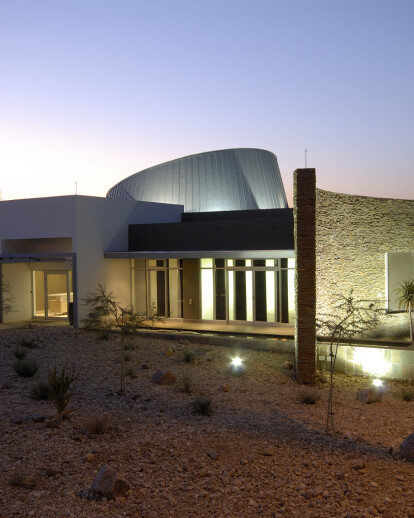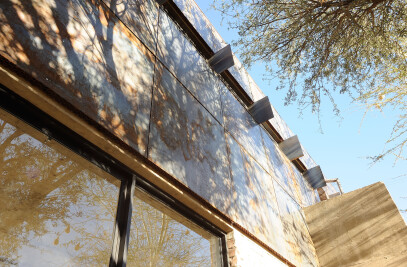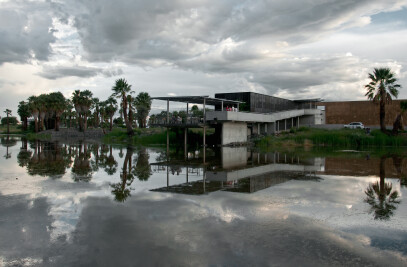As a building that represents an innovative, unconventional, and rather exceptional company, the new Namibian head office for Ernst & Young Chartered Accountants has been conceived to give expression to these qualities in a manner that challenges traditional relationships between culture, environment, structure and space, while accommodating the organisation’s progressive working methods. Every effort was made to avoid a stereotypical office solution and to resolve the brief in such a way as to announce the EY identity within the Windhoek urban environment with aplomb and eloquence. Hemmed in by streets on three sides and sloping down to a small watercourse, the site for the new head office is located in a decentralised commercial node in the suburb of Klein Windhoek and surrounded by hills and low-density residential development. Views onto the site from these surroundings dictated a sensitive approach to form giving, scale, site planning, and the use of materials. Transparency and legibility were key design considerations from the outset: a strong circulation axis leads the visitor along a shaded entrance walkway to a reception area where glimpses of the building interior are introduced. This walkway also serves as a visual barrier separating the lowerlying staff parking area from the generous open space embracing the public face of the building. Once inside the building, the visitor is exposed to its entire workings. A clear hierarchy of space from public to private is maintained without introducing physical barriers: the prominent circulation axis terminates in a system of ramps intersecting the double-volume ungulum that forms the heart of the complex. The distinctive company ethos of Ernst & Young is echoed in the design of both the building’s spatial and office environment through: • the prioritisation of a ‘People First’ philosophy: an unusually large proportion of floor area is dedicated to non-work, staff-related functions ( 28% of the total floor area) • the down-play of corporate hierarchy: a deliberate absence of cellular office space unless needed for visual and/or acoustic privacy – partners are seated within the open office configuration, with the cellular offices a series of meeting and quiet rooms on the east side of each office floor • the concept of generic seating: an open-plan office arrangement with a generic, nondedicated seating configuration – a first-come-first-served principle applies, and at day’s end personal belongings are locked away in lockers The new head office complex is the architectural manifestation of these unique Ernst & Young dynamics, set firmly within a Namibian context. Namibian vernacular architecture served as an abstract for the new building at the request of the client. This found expression not only in a spatial organisation that emulates the traditional Ambo homestead with its all important ‘olupale’, a centralised circular meeting space, but also in the juxtaposing of old and new, both in the making of form and use of materials: for example, the central space with its conical shape, whilst reminiscent of traditional shelter, is truncated in a contemporary fashion, while the rigidity of the rectangular office blocks is contrasted with the organic forms of the drum and the curved stone wall. The combination of organic and manufactured surfaces (stone and water versus steel, concrete, and porcelain) and the alternations between opacity and transparency create a dynamic visual and sensory experience. In addition to corporate identity and context, other design parameters include the shape and pronounced slope of the site, access, climatic concerns orientation, and security. The truncated cone has a double-skinned ventilated structure that helps to reduce heat gain: the use of Rheinzink as cladding is a first for Namibia – it is pure zinc, long lasting and maintenancefree, and meets the most stringent ecological requirements. The decorations within the building interior serve to reinforce a Namibian flavour and references. Twenty-eight light pendants are suspended from the roof of the central drum symbolising the twenty-eight living languages listed for Namibia, and local artist Francois de Necker was commissioned to create a wall-mounted mobile of recycled materials depicting various cultural and economic symbols of Namibia.
This project revceived an Award of Merit from the Namibia Institute of Architects in 2010.

































